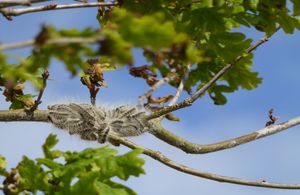Forestry Commission strengthens support to manage oak tree pest
New pilot initiatives and increased support for private residents offered to manage Oak Processionary Moth

The Forestry Commission is providing a package of new guidance and support for landowners and the public to help with the management of the Oak Processionary Moth (OPM).
OPM caterpillars and their nests contain hairs which can cause itchy rashes, eye and throat irritations, and should not be touched under any circumstances at any time. The greatest risk period is May to July when the caterpillars emerge and feed before pupating into adult moths. As OPM season begins in March, changes to the operational boundaries of the management zones – the Pest-Free Area, Buffer Zone, and Established Area – will be implemented to further restrict the spread of the pest.
An expanded Established Area will be created to cover the main area of infestation. The new support, announced today by the Forestry Commission, will provide landowners in this Area with greater flexibility in managing OPM according to local circumstances and individual site risks, aided by two new forms of financial support. These are the Private Residents’ Pilot, applications for which are now open with a deadline of 21st February 2022; and OPM Facilitation grants, which will support coordination between landowners at a local level as part of the Tree Health Pilot.
Moreover, an extended Buffer Zone, where an annual programme of OPM surveillance and control takes place, will be implemented to combat the spread of OPM into the Pest-Free Area, which covers the rest of the UK.
In addition, to help minimise the impact of the pest and limit its spread, an extensive package of online tools and guidance has been developed:
- Updated guidance on Gov.uk with information on how to identify and manage OPM
- The new OPM hub will offer advice on how to develop an OPM management plan
- An interactive map to help identify where OPM is currently found within the Established Area and Buffer Zone
- A toolkit for local authorities and larger landowners to help plan for and manage OPM
Nicola Spence, the UK Chief Plant Health Officer, said:
Oak processionary moth larvae can cause significant damage to oak trees and pose a risk to human and animal health.
These new measures are designed to improve support to landowners, minimise the spread and impact of the pest and ensure our precious oak is retained in the landscape, as part of our wider tree health protection regime. Any sightings should be reported to the Forestry Commission via its TreeAlert online portal.
Over the last five years, the Government has invested over £10 million into oak health, including the management of the OPM outbreak as well as research to develop novel control techniques and new policy responses.